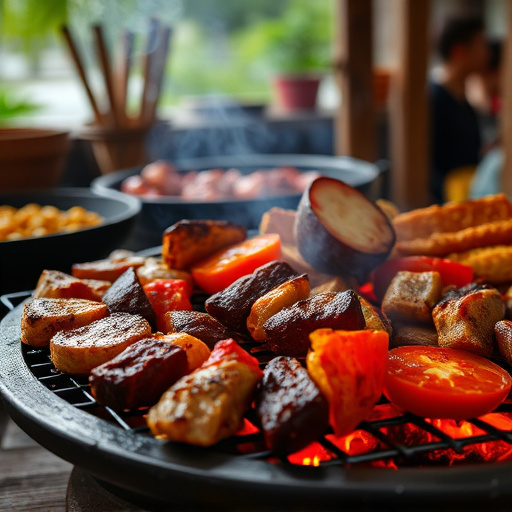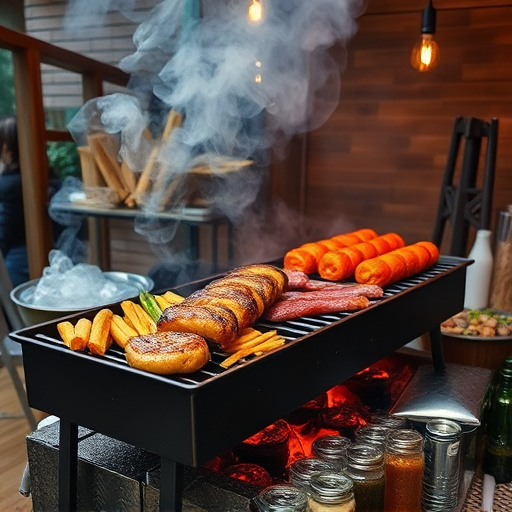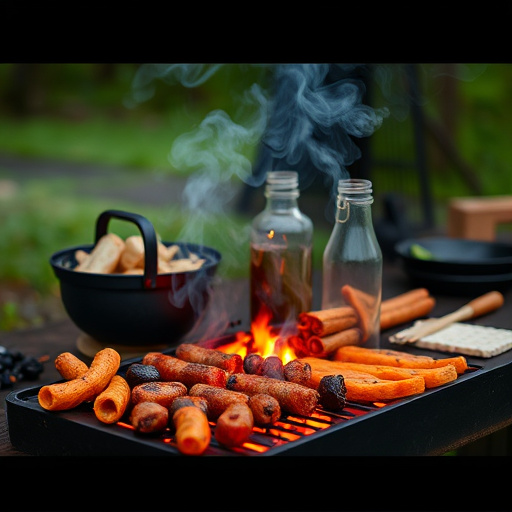The South's BBQ ribs showcase diverse regional flavors and techniques, from saucy North Carolina to Memphis' dry rubs. This culinary journey highlights unique recipes like Eastern brown sugar ribs or Western hardwood-smoked ribs, each with secret ingredients and cooking styles. Slow-cooking is key for tender meat, with variations in methods enhancing textures and flavors, making every bite an exploration of regional heritage through Ribs BBQ Recipe.
“Uncover the diverse flavors of regional barbecue ribs in this mouthwatering exploration. From the iconic South, known for its rich BBQ heritage, to the contrasting Eastern and Western styles, every corner of the country boasts unique twists on the classic ribs recipe. Delve into the art of dry rubs versus saucy marinades, uncover secret ingredients, and discover the secrets behind slow-cooking techniques that transform simple ribs into a culinary masterpiece. Elevate your Ribs BBQ Recipe with these regional variations.”
- Unveiling the South's BBQ Ribs Legacy
- Dry Rub vs. Sauce: A Regional Debate
- Exploring Eastern and Western Styles
- Unique Ingredient Secrets Revealed
- The Art of Slow-Cooking Techniques
Unveiling the South's BBQ Ribs Legacy

The South is renowned for its barbecue culture, and at the heart of this culinary tradition lies a timeless classic: barbecue ribs. Unveiling the legacy of Southern BBQ ribs reveals a rich history deeply rooted in the region’s diverse communities. Each state within the South boasts its unique style, from the slow-cooked, saucy ribs of North Carolina to the rub-focused, dry-heat method of Memphis, Tennessee. These regional variations have evolved over generations, passed down through families and local eateries, solidifying themselves as a symbol of Southern hospitality and culinary pride.
Exploring these diverse rib recipes offers more than just a taste of regional identity; it’s a journey into the heart of community traditions. Whether it’s the sweet and tangy sauce of Kansas City, Missouri, or the spicy, vinegar-based dry rub of Texas, each region has developed its own distinctive flavors, techniques, and presentation, making BBQ ribs an ever-evolving culinary treasure in the South.
Dry Rub vs. Sauce: A Regional Debate

In the world of ribs BBQ, a heated debate often emerges among enthusiasts: dry rub versus sauce. This divide is as regional as the flavors themselves. Some advocate for the simple yet robust approach of a dry rub—a blend of spices carefully measured and applied to the meat. The beauty lies in allowing the natural flavors of the ribs and the quality of the rub to shine, creating a symphony of spices that coats every nook and cranny.
On the other hand, sauce lovers argue for the sweet and tangy sensation brought by BBQ sauces. These sauces, often a mix of tomato-based ingredients, sugar, vinegar, and a variety of spices, add a layer of complexity and moisture to the ribs. In regions where tomatoes grow aplenty, sauces are as integral to the dining experience as the ribs themselves, with each family or restaurant claiming their unique recipe as the best. This regional diversity in cooking styles makes exploring different parts of the country an exciting prospect for any rib connoisseur looking for the perfect Ribs BBQ Recipe.
Exploring Eastern and Western Styles

Exploring the diverse culinary landscape of barbecue ribs, one finds a striking contrast between Eastern and Western styles, each boasting unique flavors and preparation techniques that have evolved over generations. The East, known for its rich, smoky tastes, often utilizes a blend of spices and sauces to enhance the natural sweetness of pork ribs. Popular ribs BBQ recipes from this region might include slow-roasted ribs marinated in a combination of brown sugar, paprika, and garlic, resulting in tender, succulent meat that melts in your mouth.
In contrast, Western styles tend towards a more minimalistic approach, focusing on the distinct flavors of wood smoke. Here, ribs are typically rubbed with a dry spice mix before slow-cooking over hardwood fires, allowing the natural juices and proteins to caramelize, creating a deeply savory taste. Whether you’re a fan of Eastern sweetness or Western smokiness, exploring these regional variations offers a delightful journey for any ribs BBQ enthusiast.
Unique Ingredient Secrets Revealed

When it comes to crafting the perfect ribs BBQ recipe, regional variations introduce a fascinating array of unique ingredient secrets. Each area boasts its own distinct flavors and cooking styles, from smoky spices to secret sauces. For instance, Texas-style ribs are renowned for their dry rub, a blend of coarse salt, pepper, and various spices like paprika and garlic powder, which imparts a robust, slightly sweet taste after slow-smoking the meat.
In contrast, Memphis-style ribs are often slathered in a tangy tomato-based sauce, rich in vinegar and mustard, adding a juicy kick. Carolina-style takes a different approach entirely, favoring a dry, coarse rub and a side of vinegar-based “mop” sauce, allowing the natural flavors of the ribs to shine through. These regional secrets contribute to the vibrant diversity of BBQ rib experiences, making every bite a delightful adventure for your taste buds.
The Art of Slow-Cooking Techniques

The art of slow-cooking is a crucial aspect of crafting the perfect Ribs BBQ Recipe. This technique allows the meat to tenderize and infuse flavors deeply. By using low heat over an extended period, the collagen in the ribs breaks down, transforming into gelatin, which makes the meat incredibly juicy and tender. Many BBQ enthusiasts swear by this method, as it ensures that every bite is mouthwatering.
Regional variations often come into play here, with different cultures adopting their own slow-cooking methods. Some use traditional brick ovens or wood-fired pits, while others rely on modern smokers. The temperature and cooking time can vary, resulting in unique textures and flavors. This attention to detail is what sets apart a good Ribs BBQ Recipe from an exceptional one, capturing the essence of each region’s culinary heritage.
